
The Shoah and the Second Generation:
Graphical Representation: The Unusual Structure of Maus

 |
The Shoah and the Second Generation:Graphical Representation: The Unusual Structure of Maus |
 |
| Click here for a printable version of this hypermedia project. |
A long-standing icon of Americana, the comic book has usually been categorized as a low-brow means of expression, often evoking remembrances of childhood and humorous themes. A sweeping generalization of the genre usually occurs in literary circles, which are quick to label the medium unfit for serious and sophisticated discussion. While a large portion of the graphic works tend to center on supernatural matters such as superheroes, scores of artists have taken the medium to new heights, incorporating dazzling visual dimensions to the textual ones, resulting in remarkable two-dimensional works of art. As Edmund Kannenberg writes, "comics offer the potential of dynamic narratives, as opposed to the more static single-image narrative painting."1 These oeuvres have transcended traditional limitations and expectations, producing pieces that defy categorization and boundaries.
The artistic qualities of these works, when coupled with interesting and thoroughly absorbing topics, produce serious, admirable literary masterpieces. The graphic medium offers a visual means of expressing information, an avenue often better suited for representation than mere words. The maxim "a picture is worth a thousand words" may not apply to every single example, but it does to many, such as Maus. By recalling humankind's fundamental and original process of cognition--after all, humans learn to see before they learn to read--comics trigger a natural and intuitive channel of information gathering and data processing.
Historical events and topics such as the Holocaust are often too horrible, stark, and profane to be aptly and fully represented by mere text. This "problem of representation"--encountered by hundreds of Holocaust survivors not only in written narratives, but also in their daily lives--presents a formidable dilemma for those who attempt to use traditional means of expression. It is often difficult to write on such a topic without distorting the memory, or subconsciously adding personal or communal ideas to the work. Words fail to convey the full range of meaning when dealing with a theme as incomprehensible and inhumane as the extermination of six million human beings.
Comics, on the other hand, "possess a graphical quality well-suited to a confrontation with Nazism and the Holocaust".2 It is hard enough for the mind to comprehend why almost an entire race was systematically murdered; it is perhaps impossible for words to fully represent the unthinkable and unexplainable. Spiegelman's chosen medium, and its visual nature, not only present the theme, but they also criticize it. The Third Reich's genocidial nature is portrayed as animal-like, unthinkable to rational beings. Using sworn enemies such as cat and mice to exemplify the stance does add to the graphical factor, but its relevance is subservient to its true didactic purpose.
Graphic novels, thus, are quite apt at portraying reality than can hardly be explained-or even represented—by traditional, text-based, methods of expression. The Holocaust fits this mantle perfectly, despite the existence of many remarkable and awe-inspiring novels and survivor memoirs. As Stephen Tabachnick writes, Spiegelman might have composed Maus in such a format because he is a cartoonist by trade, but "he may have also felt that the other ways of dealing with the Holocaust had already been exhausted".3 The format of his oeuvre is indeed revolutionary and unorthodox—as critics have often mentioned—but also remarkably capable of presenting the stark reality in a manner that is both didactical and cathartic.
By his own acknowledgment, Spiegelman's main influence has been MAD Magazine. First published in the 1950s, the satire journal is a breed of comic book and graphic novel, since it has neither the length of the former nor the latter. A staple of American adolescence, the magazine pioneered a new wave of graphical humor. Uncensored, irreverent, and unafraid to touch such taboo subjects as sex, drugs, 1960s politics, and the sweeping changes forever transforming the United States, MAD has influenced most of the younger generations of comic book artists. These new artists have characterized themselves for incorporating avant-garde topics, severing the ties between traditional comics such as Superman, Archie, and Spiderman, and darker, more philosophical themes such as urban battles between one's conscience and human nature or modern-day African American heroes.
Maus, therefore, belongs to a new class of Holocaust representations, such as the Yale-Fortunoff Video Testimony Archive. Another example of the use of dynamic media for the purpose of preserving survivor narratives, the project currently has 3,800 narratives stored in audio-visual format easily accessible for subsequent generations, once the actual survivors pass on. Acclaimed director Steven Spiegelberg has also undertaken a similar project, the Survivors of the Shoah Visual History Foundation, which is currently comprised of 100,000 hours of testimony. Much like the video archives, Spiegelman's chosen medium, the graphical novel, "fosters the liberty to take heart against the more compliant terms of the Holocaust's normal appearance in other representations."4 This last belief raises an interesting question, that being the existence of a "normal" appearance of the Holocaust in literary representations.
The Holocaust, as Spiegelman has stated, is a matter "too profane to show directly." 5 Famous Holocaust survivor and author Primo Levi himself has realized—and in his opinion, so has every author who has written on the subject—that "language lacks the words to express the offense." 6 Its terrors will terrify humankind, further difficulting the task of bringing the topic to human comprehension, a considerable barrier to the persisting desire and necessity to record the event for posterity.
This inability to thoroughly and appropriately explain the Holocaust, coupled with the equally powerful desire to do so, result in French philosopher Jacques Derrida's proclamation of the real challenge lying in "comment ne pas parler sur Auschwitz" (How not to talk about Auschwitz). 7 This opinion is in perfect harmony with Theodor Adorno's statement "to write poetry after Auschwitz is barbaric". 8 Those bold enough to write are caught between an inability to appropriately express the subject, and an equally strong desire not to let the world forget.
Enter Art Spiegelman. Through his attempt to "structure something novelistic" impaired by both his second-generation status and language's lack of ability to express, Spiegelman channels the desire and the passion to create through his artistic ability. 9 The anthropomorphic nature of Maus, inspired from early twentieth-century racist cartoons and the pulp comic periodical Funny Aminals (sic) shows the inhumane bigotry of the Nazi ideology, stripped down to the base instincts of cats and mice. Lacking conscience, cats are natural enemies of mice, which provides Spiegelman a direct connection to the historical means of Nazi brainwashing. Depicting Jews as the vermin of society, German authorities were able to convince an entire nation that the systematic murder to six million European Jews was simply natural extermination, merely survival of the fittest. Therefore, despite the straight-forward presentation of the topic, it is shown indirectly through non-human characters. In a way, the book looks at the Holocaust in much the same way one would look at the sun—indirectly, with sunglasses.
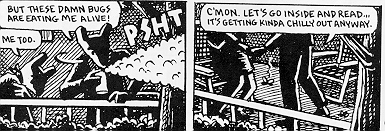
The novel succeeds, therefore, in representing such World War II horrors in the graphical format without distorting reality or trivializing the ghastly historical events. Perhaps the most glaring example of the triumph of this new manner in which to express the Holocaust, Spiegelman showed the early edition of Maus to his father Vladek—the subject of the narrative. In the CD-ROM version of the work, Spiegelman recounts how his father did not realize the drawings were not humans, but instead cats and mice. The story and the representation of the Holocaust are powerful enough for an actual survivor not to comment on the graphical nature of the work. The message, thus, is successfully transmitted, as it is not overshadowed by the medium. Despite being animals, Spiegelman's characters possess human qualities, as evident by their reflexive killing of a bug with gas. Far from trivializing the Shoah, it brings it to human terms by utilizing the cat and mice metaphor.
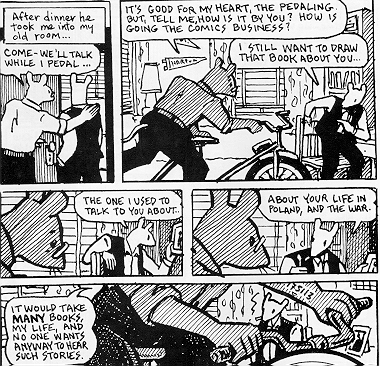
Usually regarded as restricting, the comic panels are used to divert the reader's attention into particular details, often hard to do in large illustrations such as paintings. Utilizing a visual means of expressing and processing information, Spiegelman is able to emphasize particular aspects of his story, such as the dehumanization of the Jews and the anthropomorphic characterization of the personages.
The first such example is found on page 12, as Vladek beings to recount his story while riding an exercise bike. The page commences with full body shots, switching to head drawings as Art explains his intentions. Vladek's resistance cannot be seen in his face, as the subsequent panel omits such a feature, instead showcasing his prisoner number tattoo. A ubiquitous icon of the Holocaust, the physicial scar also denoted the Jewry's subhuman condition in the eyes of the Nazis. Old and young, women and men were all seen as components of one large group, not as human beings. Spiegelman's not to draw his father's visage gives the audience a glimpse of Vladek's story, and builds the connection between the author and the reader through the work.
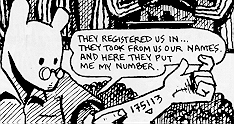
The dehumanization of the European Jewry-a fundamental component of the Third Reich's propaganda is symbolized with a highly visual reminder of the concentration camps. Unlike psychological events, tied to a survivor's soul, the cattle-like branding is physical and impossible to conceal. The tattoo is again displayed, on page 26 of the second volume, to symbolize the after-effects of the Holocaust by highlighting their omniprescence in the survivors' lives. Spiegelman utilizes the same tactic, as the illustrations display the concentration camps before switching back to Vladek, in mid-interview, pointing to his number while stating "they took from us our names, and here they put me my number."
The tattoo is not the only symbol Spiegelman uses throughout his book. The Swastika is predominantly displayed in three pages, although in entirely different fashions. As the first appearance of the Nazi icon, the flag on page 32 (as seen below) is showcased in an impacting size. The train passengers' view—also read as the first glimpse of the "new" Europe under Nazi control—occupies two-thirds of the page space. Such a trick-possible thanks to the comic format-denies the reader the chance to underestimate the image's impact.

|
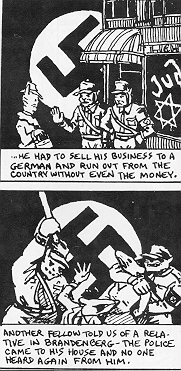
|

|
A similar use is employed on the following page, in which four panels contain a background Swastika. The icon, seen as the driving force behind the feline Nazis' brutality, informs the reader of the hypnotic effect of the German brain-washing practices. The simple yet impacting symbol, drawn over a black background, mimics the Nazi soldier-souless, mindless, and, like an animal who does not know any better, conscienceless. Lastly, the dreaded Nazi icon symbolizes the despair felt by the European Jewry during the Second World War, as avenues of escape seemingly closed overnight. Confined by the ever-limiting boundaries of Nazi occupation, forgotten and abandoned by the rest of the world, those who attempted to escape were often unsuccessful. Every route, every option, every road seemed to lead to Nazi persecution, ghettos, and concentration camps, as Spiegelman portrays on page 125.

Toward the end of the narrative, Spiegelman merges the drawn elements with photographic images, providing a contrast that reminds the reader about the ghastly reality of the historical events narrated in the novel. A device to honor fallen kin, it produces a remarkable reminder of the pain and sorrow Holocaust survivors feel for actually escaping the fate six million of their own did not. The last panel of page 116 showcases such an emotion, as Vladek's shoes (the only portion of his figure shown) tower above the photographs on the floor.
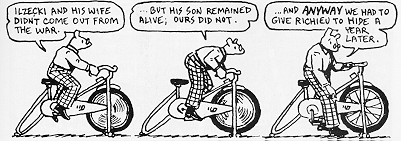
While the previously mentioned examples focus on the actual verbatim interview transcripts, there is also a plethora of instances in which the panel is enhanced by Spiegelman's interpretation of the facts and his own reflection. Page 81 displays Vladek's exercise routine, drawn on three different panels that symbolize particular stages of despair during the Holocaust. First and foremost, Vladek is riding in place, as the bicycle is stationary—much like Jewish hopes of survival as the Nazis conquered Eastern European territories in the late 30s and early 40s. Speaking of a friend's son, Vladek mentions "his son remained alive; ours did not" while trying to speed ahead to an imaginary finish line. In comparison, he stops completely when remembering Richieu, who perished during the Holocaust. The matter of fate, and Vladek's own bitterness at the inability to save his elder son, shine throughout the trio of drawings, which capture a dimension words cannot portray.
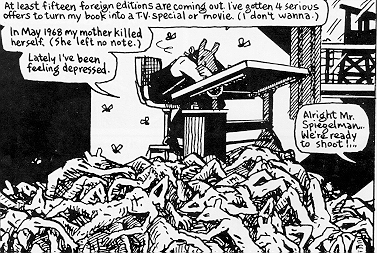
Spiegelman's weaving of personal, post-Holocaust feelings also permeate the book, as discussed on
| Introduction |
Father and Son: Maus's Story within the Story |
| Second Generation Trauma: The Post-Holocaust Experience | Conclusion and Bibliography |